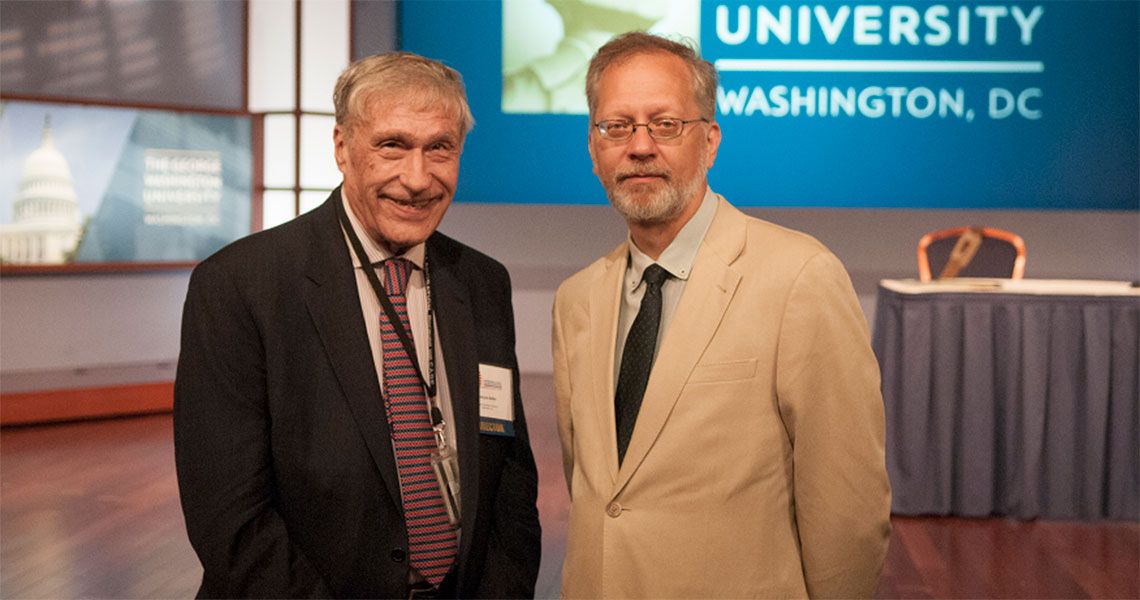The personalities at the heart of a myriad lectures at the 20th Annual International Society for the History of the Neurosciences (ISHN) Meeting span centuries, encompassing globes of music, art, literature, and pop culture: Jacques Offenbach, 19th-century composer; Michel Chevreul, 19th-century French chemist and color visionary; Thomas Stangl and Stanley Elkin, modern-day writers; and Walter Freeman, proponent of the lobotomy and the man behind Rosemary Kennedy’s fateful procedure of 1942. Encapsulated under the umbrella of neuroscience, each leader — some revolutionary, some infamous — not only contributed to the art and science of medicine, but also provided great fodder for the lecturers and participants gathered at the George Washington University (GW) in early June.
“The schedule is stocked with a lot of interesting things,” said Henry Kaminski, M.D., chair and professor of neurology at the GW School of Medicine and Health Sciences (SMHS) and chair of the plenary session of ISHN. Francois Boller, M.D., Ph.D., professor of neurology at SMHS and president of ISHN during the conference, organized the multi-day event.
Early in the agenda, Italian neuroscientist Lorenzo Lorusso, with Alessandro Porro and Antonella Franchini, examined “mechanical neuroscience” in operetta — a short, comical form of opera — in conjunction with the Industrial Revolution of the 19th century. Offenbach, one of the most popular composers of the time, tapped into the idea of body as machine in “medical masterpieces” like “Pepito” and “Le Docteur Ox,” Lorusso said. Other composers who juxtaposed body and mind with mechanical- and doll-like behaviors included Audran Edmond, composer of “La Poupée,” and Clement Philiben Léo Delibes, whose ballet, “Coppélia,” is a mainstay in performance art.
Transitioning from performance and musical art to visual art, Gul A. Russell, Ph.D., professor in the Department of Humanities in Medicine at Texas A & M University, traced the development of color theory through history. In the mid-19th century, Chevreul, she explained, who was the director of Gobelins Manufactory in Paris, was at the center of “the mystery of the fading yarns,” namely those of black and blue.
“Horrified by the concept that the dyes he had supervised could be faulty, Chevreul embarked on a rigorous examination of the dyes not only by his own manufactory, but others,” Russell said. “After a very long investigation, he came up with what he called ‘the law of simultaneous contrast of colors.’”
Despite Chevreul’s discovery that perception determined the change in the color, he was only one in a long line of curious, visually oriented scientists, including Isaac Newton, who used prisms to split light into a spectrum of color, and Ibn al-Haytham, who concluded light and color were separate entities. Russell also examined the idea of the spinning color wheel — based on a child’s spinning top – that was first developed by James Clerk Maxwell and Thomas Young in the 19th century.
Axel Karenberg, M.D., Ph.D., professor at the Institute for the History of Medicine and Medical Ethics at the University of Cologne, moved the discussion from color to text, examining the inclusion of multiple sclerosis (MS) in literature, including that of his favorite writers, Stengl and Elkin. Using both qualitative and quantitative analysis, Karenberg was able to draw several conclusions from a pool of 55 literary works.
“On the whole, literary descriptions of MS are characterized by a high degree of authenticity,” Karenberg said. “Even trivial work strives for medical accuracy.”
Additionally, Karenberg noted that depictions of physicians tend to be stereotypical — the doctor is male, cautious with prognosis, sensible with communicating diagnoses, and optimistic — and the majority of writers were American females in their 50s not suffering from MS.
In one of the most storied tales of neuroscience, physician Walter Freeman, who once headed the first Department of Neurology at SMHS, was a prolific performer and enthusiastic promoter of lobotomies. As Donald C. Shields, M.D., Ph.D., FAANS, FACS, assistant professor of neurological surgery at SMHS, explained near the end of the ISHN conference, Freeman felt the lobotomy was both an effective and economically sound procedure. He adapted his surgical procedure, enabling clinicians to perform a lobotomy in a matter of minutes, though often with mixed results.
“Sixty-three percent of these were considered improved, while 23 percent and 14 percent were classified as unchanged or worsened, respectively,” said Shields of Freeman’s 200 surgeries conducted before 1943. One of those included Rosemary Kennedy’s lobotomy; her procedure proved unsuccessful, and the sister of President John F. Kennedy Jr. spent the rest of her life in institutions.
Freeman, who traveled the country in his “lobotomobile,” training the staff at regional mental institutions, performed thousands of lobotomies over his career. The development of thorazine in the second half of the 20th century, which was originally marketed as a “lobotomy in a pill,” effectively ended Freeman’s streak of neurosurgeries.
While personalities peppered the range of topics at the ISHN conference, other highlights of the event, sponsored by the GW Department of Neurology and the Department of History, included keynote speaker Daniel Drachman, M.D., who presented the history myasthenia gravis, and a trio of symposia. This year’s conference also emphasized the history and future of drug development and incorporated poster presentations.



